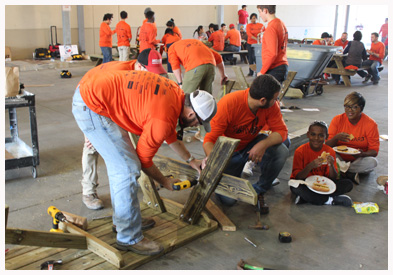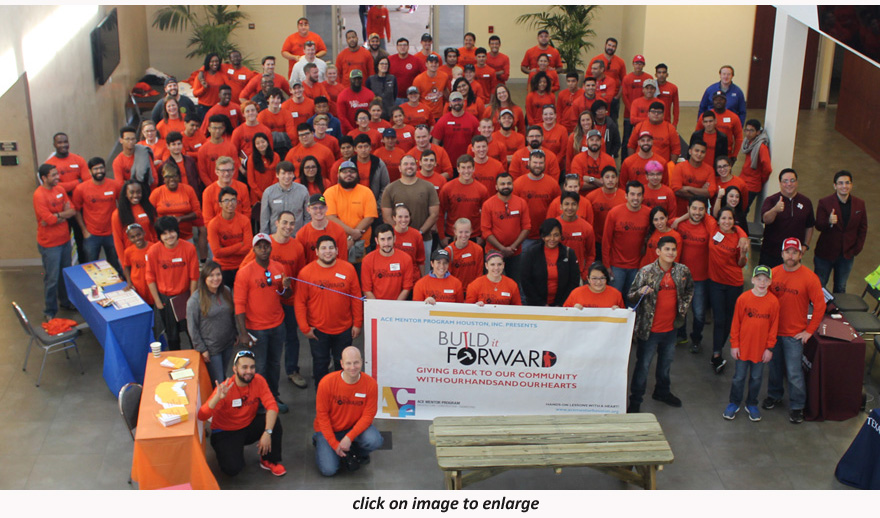 Gilbane Building Company is one of over 30 companies who sponsor the ACE Mentor Program Houston, an organization which connects volunteer mentors currently working in the Architecture, Construction, and Engineering industries to Houston-area high school students. A few weeks ago, I sat down with Angela Cotie, Project Executive at Gilbane and ACE Houston Chairman of the Board, to learn about the program.
Gilbane Building Company is one of over 30 companies who sponsor the ACE Mentor Program Houston, an organization which connects volunteer mentors currently working in the Architecture, Construction, and Engineering industries to Houston-area high school students. A few weeks ago, I sat down with Angela Cotie, Project Executive at Gilbane and ACE Houston Chairman of the Board, to learn about the program.
Cotie told me that the after-school program runs from October through April each year. Teams of students are allowed to explore all the varied careers involved in creating a project. Students work with architects, landscape architects, interior designers, structural engineers, mechanical engineers, contractors, and subcontractors to put together a building project from scratch: executing the plan, design, layout, projected cost – everything except the actual build. Their assigned RFP (request for proposal) might be a park along Buffalo Bayou or a facility such as a dog park (in which the students might design a structure that looks like a dog with a curly tail posing as a slide). Cotie said, “That’s where most of our minds were when we were in high school: we wanted to think big, and it keeps a lot of our mentors grounded.” Cotie continued: “You know, it is funny: when it comes to helping these students, even thought I have high school kids of my own, it really puts into perspective how fortunate my own kids are. I would hope that if my kids were in a different situation, that there would be adults that stepped up to do these kind of things. My son right now wants to work in agriculture. He has a science brain, and that’s what he likes to do. I don’t know anything about agriculture, so if he has mentors and folks to direct him, regardless of our means, I think that’s really cool that he gets those opportunities.”
Cotie continued: “You know, it is funny: when it comes to helping these students, even thought I have high school kids of my own, it really puts into perspective how fortunate my own kids are. I would hope that if my kids were in a different situation, that there would be adults that stepped up to do these kind of things. My son right now wants to work in agriculture. He has a science brain, and that’s what he likes to do. I don’t know anything about agriculture, so if he has mentors and folks to direct him, regardless of our means, I think that’s really cool that he gets those opportunities.”
Now in their ninth year, ACE Mentor Program Houston has nine locations throughout the Houston area varying from high school or community college campuses to businesses, to trade organizations. Cotie said that these locations serve as “neutral places” where it does not matter which company each volunteer works for; the industry leaders are there to teach the students. She said that in this environment there is not a lot of business talk, but instead there is relationship building.
While the program is considered extracurricular for most students, some high schools have found a way to apply participation to acedemic credit. There are even some home-schooled students who participate. The program is free for all students, and is financed through volunteerism, donations, and one big annual fundraiser called Build It Forward. The idea for Build It Forward grew out of the desire to allow the students themselves to be a part of the fundraiser which supports the program and funds scholarships each year. Cotie told me, “A lot of our students are receipents of charity, so I wanted them to see that they could give back by using their hands. I think even what just happened with the hurricane [Harvey] demonstrated that to them. You don’t have to have a lot of money to put on a dust mask and pull out drywall from somebody’s house. To have a skill to do something, or to just use your energy feels good. It feels pretty good to help somebody, and it doesn’t cost you anything to go sweep up somebody’s house who needs it.”
The program is free for all students, and is financed through volunteerism, donations, and one big annual fundraiser called Build It Forward. The idea for Build It Forward grew out of the desire to allow the students themselves to be a part of the fundraiser which supports the program and funds scholarships each year. Cotie told me, “A lot of our students are receipents of charity, so I wanted them to see that they could give back by using their hands. I think even what just happened with the hurricane [Harvey] demonstrated that to them. You don’t have to have a lot of money to put on a dust mask and pull out drywall from somebody’s house. To have a skill to do something, or to just use your energy feels good. It feels pretty good to help somebody, and it doesn’t cost you anything to go sweep up somebody’s house who needs it.”
The sixth annual Build It Forward event was held on December 2 at the MAREK facility, as it has been in past years. High school students from across the Houston area assembled at 8:00 am on Saturday morning to build picnic tables slated for donation to local charities such as Boy Scouts of America, Habitat for Horses, YMCA, and other organizations. Cotie described the plan for the day, remarking that she wanted the workday to stay “grassroots.” The students would start the day with “stretch and flex” to prepare their bodies for the work. There would be a D.J. pumping music, while teams formed of randomly selected students and mentors  (rather than groups who already knew each other) built the picnic tables. MAREK cut the wood pieces for each table before the event, to ensure the safety of all who participated, both students and mentors alike. (Many of the mentors are engineers, architects, and other professionals who do not work with saws and other power tools in their daily jobs.) Lunch was prepared by volunteers grilling hamburgers and other fare while the students assembled the tables – which were then used to eat on when completed!
(rather than groups who already knew each other) built the picnic tables. MAREK cut the wood pieces for each table before the event, to ensure the safety of all who participated, both students and mentors alike. (Many of the mentors are engineers, architects, and other professionals who do not work with saws and other power tools in their daily jobs.) Lunch was prepared by volunteers grilling hamburgers and other fare while the students assembled the tables – which were then used to eat on when completed!
This year the projects built by each group were picnic tables. Over the years, the Build It Forward teams have built sheds, benches, and now tables – all given to various charities. Often alumni of the program return to volunteer at the Build It Forward events. Sometimes organizations who are to receive one of the projects attend the event in order to show the ACE students what their charity organization is about. An example of this is when in a past year, a special needs group that studies karate gave a demonstration for the ACE students during a break from building the project that year.
Cotie recently finished a presentation at a company from which she hoped to recruit mentors and other volunteers for the ACE Mentor Program Houston. She shared that sometimes architects are harder to recruit, because their schedules are different from some others in the industry; many of them work late in the evening, making it hard for them to volunteer at after-school programs. A young female architect approached Cotie following her presentation, saying “I am an ACE mentee!” This made Cotie’s day as she told me, “This shows that they are out there, and they are actually coming back!”
A survey collected by the national ACE Mentor Program in which 96 of last year’s nearly 300 ACE Mentor Program Houston students responded showed that 96% of the students felt that they had gained leadership experience and confidence – things that Cotie pointed out are over and above just learning about the industry.  She shared this with last year’s mentors to show them, “Look at how successful we were!” which resulted in many agreeing to volunteer as mentors for another year. Other responses students gave in that survey include:
She shared this with last year’s mentors to show them, “Look at how successful we were!” which resulted in many agreeing to volunteer as mentors for another year. Other responses students gave in that survey include:
- “It has made me aware of the work that goes into building and all the job titles and people that are needed in order to accomplish a common goal.”
- “The ACE Mentor Program has affected me by giving me better leadership skills and has taught me what goes behind the process of building a structure.”
- “It has given me a new perspective to the different engineering careers and how they affect the world around us.”
In an upcoming post I will share what I learned when I talked with several key volunteers during this year’s Build It Forward workday and fundraiser.
ACE Mentor Program Houston is part of the national organization ACE Mentor Program of America, Inc, an organization with over 70 affiliates across America with the goal of introducing high school students to the Architecture, Construction, and Engineering Industries. Other ACE Mentor Program affiliates in Texas include those in San Antonio, Austin, and Dallas. ACE Mentor Program Houston is the second largest ACE affiliate in the country, and is a 501c3 organization run completely by volunteers. To make a tax-deductible contribution to support Houston’s ACE community or to learn how you can become involved in this worthy program, visit their website.


